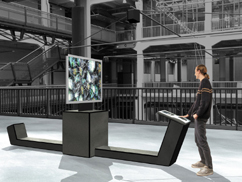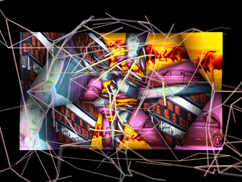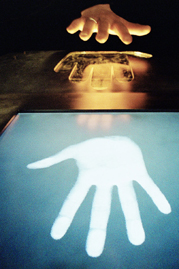|
|
|

|

|

|

|
 December.20 (Friday), 2002 - March.28 (Friday), 2003 Entrance Lobby December.20 (Friday), 2002 - March.28 (Friday), 2003 Entrance Lobby
|
|
Works |

|
|
"Web of Life"
|
| 2002
|
|
Michael GLEICH +
Jeffrey SHAW +
Bernd LINTERMANN +
Lawrence WALLEN +
Torsten BELSCHNER +
Manfred WOLFF-PLOTTEGG +
Andreas KRATKY +
Fabian NICOLAY
|





Photo: OTAKA Takashi
|
The artwork's algorithmic emergent tapestry of audiovisual and thematic
correspondences is activated and modulated by the patterns derived
from the palms of visitors' hands that are being scanned and entered
into the system from the local and remote input terminals. These varied
and always uniquely individual palm lines appear on the installation's
screen, with a caption indicating the name of the location where that
person's hand was scanned, e.g., New York, Tokyo, Berlin, Melbourne,
etc. These lines then merge into and activate a singular sequence
of transformations on the screen, and also in the musical score that
accompanies the imagery. In this way each visitor connects with and
breathes new life into this networked artwork - with a ritual handshake
they awaken a fascinating world of visual and thematic correlations
and make themselves protagonists of the Web of Life. The projected
imagery, which is computed in real time, is continually creating manifold
structures and patterns that evoke an organic network of pictorial
and thematic relations, such as the neuronal circuits of the human
brain, the urban lattice of streets, the leads on a printed circuit
board, the fan of waterways at a river delta, or the filigree of arteries
in the human body. This iconographic articulation of network structures
and processes is further enhanced by the combinatory integration of
video sequences that are dynamically selected from a large database
of creatively processed archival footage.
The Web of Life's projections are implemented with custom software,
the basic underlying concept of which is that of the network. It is
an interactive and extensible coded environment in which special programs
- known as nodes - are connected and communicatively generate changing
visual networks in real time. Single program nodes process special
tasks such as the control of the user interface, the selection and
playing of movies, the modification of the visual network, and communication
over the Internet. The visual network is programmed as a self-organizing
system, utilizing biology-derived metaphors such as neuronal growth.
The audio rendering environment enables the user to experience soundfield
movements in three dimensions by means of true multi-channel audio
projection. The aesthetic aim behind this approach is to create dynamic
webs of sound vectors all around the visitors, and to imprint this
sound image as a gestalt onto their perception. These three-dimensional
sound gestalts move within their virtual sound spaces in varying relationships
with the graphics.
The sound engine is laid out in a twofold manner. One layer is constructed
as a network of sound streams that interlock with each other in various
ways in relationship to the content structures of the imagery. A second
layer projects these streams into the installation room as the hand
lines dynamically evolve and fill the installation space over time.
Various links between the imagery and the soundscape control its levels
of complexity and spatial distribution. The audio environment inside
the ZKM installation is connected (via the Internet) to those at the
four traveling installations, so that when a new hand is scanned at
any one of these sites, a new soundscape (relating to the new image
sequence) is triggered at all locations.
|
|
